 |
Home | Charity | Feedback |
Ukraine:
Kiev
Kiev, Ukraine: Golden tops by Anuj Bang, Maharashtra, India One of the oldest cities in Eastern Europe and now the capital of independent Ukraine, Kiev was founded by a Slavic family consisting of 3 brothers, Kyi, Scheck, and Khoryv and their sister Lybid some 1400 years back. Between now and then Kiev has come under the rule of various empires from Kievan Rus to Mongolian to Lithuanian to Polish to Russian. For some empires it was the centre of power and prosperity and some left it to decline and decay. Amidst all this, Kiev has retained its own unique culture along with its pastel coloured buildings and golden domed churches and monasteries. 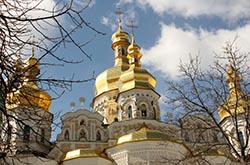 I was in Kiev for 4 days on business and managed to take out few hours to tour the beautiful city. It was end of March and the weather was rather cold, windy and snowy. During peak winter months of January and February the temperatures can easily dip to 30 degrees Celsius below 0. It is essential to choose the right place to stay because most of the hotels in the city are from the Soviet era and many things won’t work in them including heaters and geysers. I was fortunate to have booked a suite at the Express Hotel on Shevchenko Boulevard right in the centre of city which had everything working perfectly. The hotel comes with my recommendation as it has a safe location and is barely 10 minutes’ walk from the lively Khreschatyk Street.
I was in Kiev for 4 days on business and managed to take out few hours to tour the beautiful city. It was end of March and the weather was rather cold, windy and snowy. During peak winter months of January and February the temperatures can easily dip to 30 degrees Celsius below 0. It is essential to choose the right place to stay because most of the hotels in the city are from the Soviet era and many things won’t work in them including heaters and geysers. I was fortunate to have booked a suite at the Express Hotel on Shevchenko Boulevard right in the centre of city which had everything working perfectly. The hotel comes with my recommendation as it has a safe location and is barely 10 minutes’ walk from the lively Khreschatyk Street.
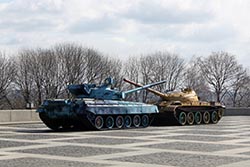 Getting a visa for Ukraine can be a rather daunting and time consuming task for Indians and other non EU nations. All sorts of permissions and documents are required to even qualify to apply for it. You would need the permission from the Ukrainian police for your visit and a local Ukrainian acting as the guarantor too. Without the help of my business partners in Ukraine it would have been rather impossible to get the visa.
Getting a visa for Ukraine can be a rather daunting and time consuming task for Indians and other non EU nations. All sorts of permissions and documents are required to even qualify to apply for it. You would need the permission from the Ukrainian police for your visit and a local Ukrainian acting as the guarantor too. Without the help of my business partners in Ukraine it would have been rather impossible to get the visa.
Now that I had my feet on the Ukrainian land, I was in hands of my friend Volodymyr to show me around Kiev and act as my language interpreter. It you don’t speak Russian, it is necessary to have someone with you understanding English and Russian or be ready to get lost. Since Ukraine is the hosting country for the 2012 Euro football championship, the locals were getting trained in English and the process was on to include street signage in English as well. 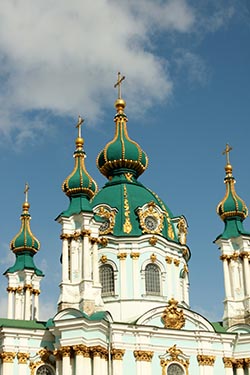 Since we only had a few hours in hand, we decided to quickly hop around all the major tourist sites in Kiev. Starting from our hotel we crossed the Shevchenko Boulevard, passing St. Volodymyr’s Cathedral – a beautiful pastel yellow cathedral with golden dome, botanical garden, Taras Shevchenko University and the Prime Palace hotel – the first luxury hotel of Kiev. You will find many important places and monuments named after Taras Shevchenko as he is the most celebrated poet in Ukraine. He means the same to Russian language as Shakespeare means to the English language. Passing the National Opera House we reached our first stop of the day - The Golden Gate of Kiev.
Since we only had a few hours in hand, we decided to quickly hop around all the major tourist sites in Kiev. Starting from our hotel we crossed the Shevchenko Boulevard, passing St. Volodymyr’s Cathedral – a beautiful pastel yellow cathedral with golden dome, botanical garden, Taras Shevchenko University and the Prime Palace hotel – the first luxury hotel of Kiev. You will find many important places and monuments named after Taras Shevchenko as he is the most celebrated poet in Ukraine. He means the same to Russian language as Shakespeare means to the English language. Passing the National Opera House we reached our first stop of the day - The Golden Gate of Kiev.
The Golden Gate is a major landmark of ancient Kiev and acted as gateway to the ancient city fortress. Contrary to its name, it has nothing golden in it. As was most of Kiev, the Golden Gate was totally destroyed during the Second World War and the reconstruction completed in 1982. Currently it serves as a museum. After a brief photo stop we headed towards St. Sophia Cathedral. 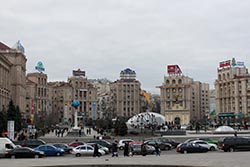 St. Sophia Cathedral is an outstanding architectural monument recognized by the UNESCO World Heritage Program and named as one of the seven wonders of Ukraine. Aside from its main building, the cathedral includes an ensemble of supporting structures such as a bell tower, the House of Metropolitan, and others. We entered the complex from Sophia Square on which the monument of Bohdan Khmelnytsky is erected – a hetman who led an uprising against the Commonwealth and its magnates in the 17th century. A fee of 40 Hryvnya (also known as Grivna) needs to be paid to enter the complex. During time of my visit 1 Euro got me 10.65 Hryvnya. Passing below the bell tower gates we entered the sprawling premise of the cathedral and took a short walk in its nice manicured gardens.
St. Sophia Cathedral is an outstanding architectural monument recognized by the UNESCO World Heritage Program and named as one of the seven wonders of Ukraine. Aside from its main building, the cathedral includes an ensemble of supporting structures such as a bell tower, the House of Metropolitan, and others. We entered the complex from Sophia Square on which the monument of Bohdan Khmelnytsky is erected – a hetman who led an uprising against the Commonwealth and its magnates in the 17th century. A fee of 40 Hryvnya (also known as Grivna) needs to be paid to enter the complex. During time of my visit 1 Euro got me 10.65 Hryvnya. Passing below the bell tower gates we entered the sprawling premise of the cathedral and took a short walk in its nice manicured gardens.
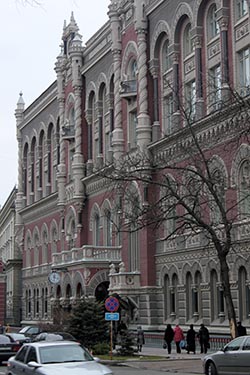 Speaking of churches and cathedrals it is interesting to note that Ukraine was one of the centres from where Eastern Orthodox Church took birth and majority of the population follow the faith of Orthodox Christianity. Festivals like Christmas and Easter fall on different dates than what most of us are aware of. It is easy to distinguish orthodox churches thanks to their striking onion shaped domes. In Russia the domes are colourful, in Kiev they are golden.
Speaking of churches and cathedrals it is interesting to note that Ukraine was one of the centres from where Eastern Orthodox Church took birth and majority of the population follow the faith of Orthodox Christianity. Festivals like Christmas and Easter fall on different dates than what most of us are aware of. It is easy to distinguish orthodox churches thanks to their striking onion shaped domes. In Russia the domes are colourful, in Kiev they are golden.
A short walk straight down the road brought us to St. Michael's Golden-Domed Monastery - A pastel blue building with numerous golden domes. The religious architecture of St. Michael's Golden-Domed Monastery incorporates elements that have evolved from styles prevalent during Byzantine and Baroque periods. We entered the cathedral for a short prayer service. It is important to note that no photographs are allowed inside any of the cathedrals and monasteries in Kiev and women should cover their head before entering the premise. 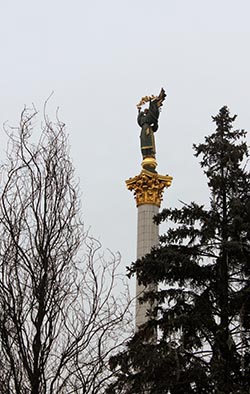 A short uphill walk passing the Ministry of Foreign Affairs we reached St. Andrew’s Church. It is a major Baroque church constructed in the 18th century by the Imperial Russian architect Bartolomeo Rastrelli. It has a huge green dome with intricate carvings in gold. I have to admit it was one of the most beautiful domes I have come across in my life. Unfortunately, we could not enter the church as it was undergoing major renovations.
A short uphill walk passing the Ministry of Foreign Affairs we reached St. Andrew’s Church. It is a major Baroque church constructed in the 18th century by the Imperial Russian architect Bartolomeo Rastrelli. It has a huge green dome with intricate carvings in gold. I have to admit it was one of the most beautiful domes I have come across in my life. Unfortunately, we could not enter the church as it was undergoing major renovations.
From St. Andrew’s Church, passing the Dynamo Kiev football stadium we drove towards the museum of the Great Patriotic War in Pechersk district. It is a memorial complex commemorating the German-Soviet War (part of WWII) located on the picturesque hills on the right-bank of the Dnieper River. It is one of the largest museums in Ukraine centred around the famous titanium bodied, 62-meter tall Motherland statue, which has become one of the best recognized landmarks of Kiev. One can go atop the statue by paying a fee of 200 Hryvnya. The museum has on display armaments, tanks and fighter planes from the WWII era. It also houses the ‘Alley of the Hero Cities’, in which the sculptures depict the courageous defence of the Soviet border from the 1941 German invasion, terrors of the Nazi occupation, partisan struggle, devoted work on the home front, and the 1943 Battle of the Dnieper. 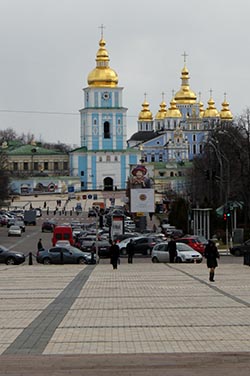 Next to the war museum is the famous Kiev Pechersk Lavra, also known as the Kiev Monastery of the Caves. Together with the Saint Sophia Cathedral, it is inscribed as a UNESCO World Heritage Site and named as one of the seven wonders of Ukraine. It is still an active monastery and there is a fee of 25 Hryvnya to enter its premise. The Kiev Pechersk Lavra contains numerous architectural monuments, ranging from bell towers to cathedrals to underground cave systems to strong stone fortification walls. What amazed me most was the very complex system of narrow and dark underground corridors, about 2 meters high and 1 meter wide, with numerous living quarters and underground chapels. Along the corridors are over a hundred burials of Saints and monks kept in glass caskets with their well-preserved bodies easily visible. Most of them are covered in cloth though. The caves are divided into two parts, the far and near caves. It has nothing to do with the distances from each other. In fact the far caves were founded before the near caves. I just walked through a small section of caves as even a day is not sufficient to cover the full maze.
Next to the war museum is the famous Kiev Pechersk Lavra, also known as the Kiev Monastery of the Caves. Together with the Saint Sophia Cathedral, it is inscribed as a UNESCO World Heritage Site and named as one of the seven wonders of Ukraine. It is still an active monastery and there is a fee of 25 Hryvnya to enter its premise. The Kiev Pechersk Lavra contains numerous architectural monuments, ranging from bell towers to cathedrals to underground cave systems to strong stone fortification walls. What amazed me most was the very complex system of narrow and dark underground corridors, about 2 meters high and 1 meter wide, with numerous living quarters and underground chapels. Along the corridors are over a hundred burials of Saints and monks kept in glass caskets with their well-preserved bodies easily visible. Most of them are covered in cloth though. The caves are divided into two parts, the far and near caves. It has nothing to do with the distances from each other. In fact the far caves were founded before the near caves. I just walked through a small section of caves as even a day is not sufficient to cover the full maze.
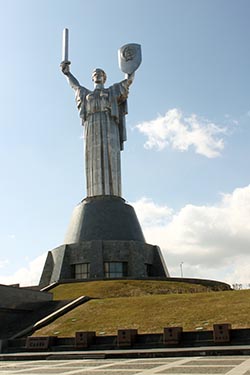 By the time we were done with the main sights of Kiev, it was lunch time. We headed back to Shevchenko Boulevard for a meal at an Italian Restaurant named Prego as business awaited for rest of the day. In the evening we had dinner at a traditional Ukrainian restaurant, Rushnychok, located on Pushkinska Street. Ukrainian cuisine is predominantly meat based with liberal use of pork. But they generally have vegetarian versions of the cuisine for people like me. Must have are Borscht - a clear beet root soup with vegetables and choice of meat generally accompanied by black bread, Deruny - potato pancakes, served with rich servings of sour cream, Varenyky - Dumplings stuffed with vegetable and meat. The one stuffed with cherries act as a filling dessert. Caviar is also very popular in Ukraine.
By the time we were done with the main sights of Kiev, it was lunch time. We headed back to Shevchenko Boulevard for a meal at an Italian Restaurant named Prego as business awaited for rest of the day. In the evening we had dinner at a traditional Ukrainian restaurant, Rushnychok, located on Pushkinska Street. Ukrainian cuisine is predominantly meat based with liberal use of pork. But they generally have vegetarian versions of the cuisine for people like me. Must have are Borscht - a clear beet root soup with vegetables and choice of meat generally accompanied by black bread, Deruny - potato pancakes, served with rich servings of sour cream, Varenyky - Dumplings stuffed with vegetable and meat. The one stuffed with cherries act as a filling dessert. Caviar is also very popular in Ukraine.
After finishing work at the International Exhibition Centre on the last day of visit, Volodymyr and I decided to complete what was left on day one. Instead of taking a taxi, which needs to be pre-booked and cannot be hailed from the streets, we took a metro from Livoberezhna station opposite the expo centre and alighted at Arsenalna Station 3 stops further. A one way metro ticket, irrespective of distance, costs 2 Hryvnya. Arsenalna station is the deepest underground station in the world at 105.5 meters. The ride on one of its escalators takes about 5 minutes. It is considered to be one of the longest in the world too. After making the way up we entered the Mariinsky Park just a few steps away. It is one of the most picturesque parks of Kiev and is very famous due to the fact that the Mariinsky Palace, the principal residence of the Ukrainian President, is situated on its territory. From the park we got panoramic views of the left-bank of Dnieper River. As it was still winter, the park was not very colourful, but I was told that all of Kiev blossoms to the brim during the spring month of May and is definitely the best month to visit the city. It is fascinating to know that Kiev is considered to be the greenest capital city in Europe. It is very true, as being there one feels as if the city is built within a forest. 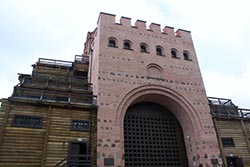 Coming back out from the park we passed a few lanes which housed parliament buildings and government offices. We also passed the grand, pink, National Bank of Ukraine building on Instytutska Street. Crossing the Bankova Street we entered the premises of President’s office which was also the site for ‘House with Chimaeras’. I was amazed to see the building with animal sculptures integrated all over its exterior. From elephants to rhinos to frogs to snakes to unicorns. You name the animal and it was sculpted there. Legend has it that the architect Vladislav Gorodetsky's daughter had committed suicide jumping into Dnieper River because of some unfortunate love affair and as a result, Gorodetsky went slightly mad and built this house in his daughter's memory.
Coming back out from the park we passed a few lanes which housed parliament buildings and government offices. We also passed the grand, pink, National Bank of Ukraine building on Instytutska Street. Crossing the Bankova Street we entered the premises of President’s office which was also the site for ‘House with Chimaeras’. I was amazed to see the building with animal sculptures integrated all over its exterior. From elephants to rhinos to frogs to snakes to unicorns. You name the animal and it was sculpted there. Legend has it that the architect Vladislav Gorodetsky's daughter had committed suicide jumping into Dnieper River because of some unfortunate love affair and as a result, Gorodetsky went slightly mad and built this house in his daughter's memory.
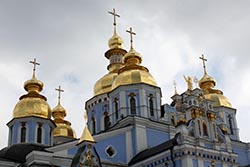 At the end of Bankova street we joined the Lyuteranska Street. It was a steep sloped street lined with pastel coloured apartment buildings leading all the way down to Khreschatyk Street – the soul of Kiev. This 1.2 kms, 8 lane street stretches from the European Square (People's Friendship Arch) through the Maidan (Independence Square) and to Bessarabska Square (Besarabsky Market). Along the street are located buildings of the Kiev City Administration and upmarket shops, malls and restaurants.
At the end of Bankova street we joined the Lyuteranska Street. It was a steep sloped street lined with pastel coloured apartment buildings leading all the way down to Khreschatyk Street – the soul of Kiev. This 1.2 kms, 8 lane street stretches from the European Square (People's Friendship Arch) through the Maidan (Independence Square) and to Bessarabska Square (Besarabsky Market). Along the street are located buildings of the Kiev City Administration and upmarket shops, malls and restaurants.
We walked to the massive Maidan Nezalezhnosti or better known as Independence Square. The square has always been the centre of public political protests and revolutions. In 2001, the grand and tall column with monument of Berehynia on top was erected at the Maidan to express Ukraine’s freedom. For the Euro 2012 tournament, the Maidan was being readied as a location for fan fest with giant digital screens and tents. 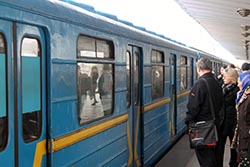 Scrumptious Ukrainian dinner awaited us at Opanas, an upmarket restaurant located amidst the Taras Shevchecko Park. To reach there, instead of going over-ground we decided to pass through the underground mega shopping mall ‘Metrograd’. It stretches from Khreschatyk to Lva Tolstoho square with many turns and corridors. It would take two or three trips to get to know Metrograd well enough to find the way out! Shops in the Metrograd sell everything from furniture to souvenirs. It gives me an impression that Kievans love life beneath the ground – let it be a monastery or a mall!
Scrumptious Ukrainian dinner awaited us at Opanas, an upmarket restaurant located amidst the Taras Shevchecko Park. To reach there, instead of going over-ground we decided to pass through the underground mega shopping mall ‘Metrograd’. It stretches from Khreschatyk to Lva Tolstoho square with many turns and corridors. It would take two or three trips to get to know Metrograd well enough to find the way out! Shops in the Metrograd sell everything from furniture to souvenirs. It gives me an impression that Kievans love life beneath the ground – let it be a monastery or a mall!
Next morning, starring outside the hotel window before bidding adieu, the sight was not a surprise - golden domes shining in the early morning sun! Kiev Image Gallery  Photo viewer Photo viewer
|
|
|
Home |
Charity |
Feedback
Privacy Policy | Terms of Usage © YoGoYo.com. All rights reserved. |









































